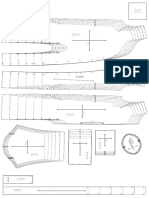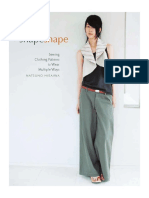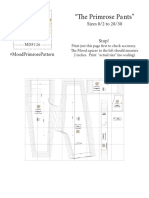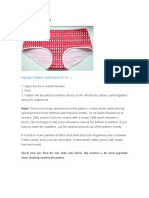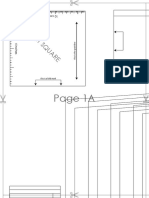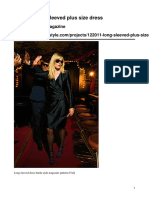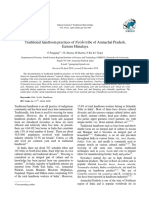PAT T E R N S
DRAW YOUR OWN
C U L O T T E PAT T E R N
�T H A N K Y O U F O R D O W N L O A D I N G A M I S U S U PAT T E R N !
We try to make great design accessible for everybody! In this tutorial we will show you
how to draft a simple base culotte pattern, how to adjust the shape a bit and how to
actually sew everything together! You don’t need to be a math genius or a sewing
wizard - if you can operate a calculator and if you are in posession of some basic
sewing skills, than this tutorial is for you! Here at Misusu we take pride in creating the
best tutorials out there - comprehensive and clear, so everybody can enjoy learning
something new!
C U L O T T E M AT E R I A L S PAT T E R N M AT E R I A L S
Flowy fabric - Tencell, cupro, viscoses or Pattern paper
a light weight cotton (blend) Tape
2,5 cm (1”) elastic tape Pencil and ruler
Contrast tape (optional) Tape measure
Pins Scissors (paper)
Safety pins
Scissors (fabric)
P R E PA R AT I O N
THIS is a tutorial for kids and grown ups,
PRE-WASH all your fabrics.
but it is written with a child in mind. With
Be sure to use the same method you
a few small adjustements this tutorial can
intend to clean your garment with when
be used for grown ups too. Just follow
finished.
the steps and choose the highlighted
“grown ups” calculations when you’re
making a culotte for a grown up.
1
�MEASUREMENTS
FOR this tutorial, we need two measure-
ments - the hip circumference (1) and the
body rise (2).
1. HIP CIRCUMFERENECE Measure
around the fullest part of the hip area,
where the buttocks is protruding the
greatest.
2. BODY RISE This measurement is
1
taken sitting down on a chair. Measure
from the waistline to the top of the chair.
The waistline is around the narrowest waist
part of the waist or midway between the
top of the hip bone and the bottom of 2
the rib cage.
With these 2 measurements you can
calculate and draw the pattern. To make
things more clear, we've added example
calculations for every step of the tutorial.
The example calculations are all in CM.
When a calculation is different in INCH,
it's highlighted in brackets.
2
�D R A F T I N G T H E B A C K PAT T E R N
2 1 2 1
3 3
STEP 1
1 - 2 = a horizontal line measuring ¹/4 Hip + ¹/10 Hip.
Example:
Hip measurement = 60 cm.
60 cm : 4 = 15 cm
60 cm : 10 = 6 cm
15 cm + 6 cm = 21cm
1 - 3 = a vertical line with the desired length of the culotte. Example length: 25 cm. This can
be as long, or short as you want! Draw perpendicular lines down from 2 and going left from 3,
creating a square.
2 1 2 1
4 4 6
3 5 3 5
STEP 2
1- 4 = Body rise measurement + 1.25 cm (IN INCHES + ¹/2” )
FOR GROWN UPS: Body rise measurement + 5 cm (IN INCHES: Body rise measurement + 2")
3 - 5 = ¹/8 Hip + 2.5 cm (IN INCHES: ¹/8 Hip + 1")
FOR GROWN UPS: ¹/8 Hip + 5 cm (IN INCHES: ¹/8 Hip + 2")
Example:
Hip measurement = 60 cm
60 cm: 8 = 7.5 cm
7.5 cm + 2.5 cm = 10 cm
3
� 2 1 2 1
7 7
8
4 6 4 6
3 3
5 5
STEP 3
4 - 7 = same measurement as 4 - 6. Draw a diagonal line between 6 - 7.
8 = middle of 6 - 7. Draw a diagonal line from 4 to 8.
2 1
7
8 BACK BASE
PATTERN
9
4 6
3 5
STEP 4
9 = middle of 4 - 8.
Draw a curved line from 7 to 6, touching 9. Your back base pattern is finished!
4
�D R A F T I N G T H E F R O N T PAT T E R N
2 1 2 1
4 4 6
3 3 5
STEP 1
Follow the same steps as for the back pattern until you’ve created point 1, 2, 3 and 4.
3 - 5 = ¹/8 Hip
Draw perpendicular lines going right from 4 and going up from 5, creating no 6.
2 1 2 1
7 7
8
4 6 4 6
3 5 3 5
STEP 2
4 - 7 = same measurement as 4 - 6. Draw a diagonal line between 6 - 7.
8 = middle of 6 - 7. Draw a diagonal line from 4 to 8.
5
� 2 1
7
8 BASE FRONT
4 9 6 PATTERN
3 5
STEP 3
9 = middle of 4 - 8.
Draw a curved line from 7 to 6, touching 9. This is your base front pattern!
DRAFTING THE WAISTBAND
2 x measurement 1-2
WAISTBAND 6 cm
(2 ³/8”)
STEP 1
Draw a rectangle measuring twice the measurement of 1-2 of your front/back pattern in lenght
and 6 cm in height. (IN INCHES: 2 3/8”)
Example:
1 - 2 of example = 21 cm
2 x 21 cm = 42 cm
This is your waistband for your front and back pattern. This will be folded into a tunnel which
will fit a 2.5 cm (1”) elastic tape.
This wasn't so hard, was it? Now there're only a few modifications left to create the perfect
culotte pattern! First off all, we need to add a front and back plead. This will create the illusion
of a real skirt.
6
�THE FRONT AND BACK PLEAD
5 cm or 2”
CE N T RE BACK L I N E
CE N T RE BACK L I N E
B A C K P A TTE R N BACK PATTERN
5 cm or 2”
STEP 1
Trace the back pattern on a new piece of paper. Cut along the centre back line, dividing the
back pattern into 2 parts. Tape a piece of paper to the centre back line of the big pattern
piece.
Extend the horizontal lines with 5 cm. (IN INCHES extend with 2")
FOR GROWN UPS: Extend with 7,5 cm. (IN INCHES extend with 3")
C E NT R E B A C K L I N E
C E NT R E B A C K L I N E
PLEAD
B A C K P A TTE R N BACK PATTERN PLEAD
STEP 2
Draw a vertical line, between the two new lines, closing the shape into a square. This is the
plead! Place the remaining pattern piece on this line and tape together.
CEN T RE F RON T L IN E
CEN T RE BA CK LI N E
P L EA D
P L EA D
B A C K P A TTE R N FRONT PATTERN
STEP 3
Cut the unnecessary paper off along the new pattern lines. Repeat all of these steps for the
front pattern.
7
�MODIFY THE SHAPE
Now it's time to modify the overall shape by adding width at the bottom of the pattern. The
next modifications will create a flared culotte like the example culotte on the photo's. Start
with the front pattern.
1 /5 1 /5 1 /5 1 /5 1 /5
CE N TE R FR O N T L IN E
CE N TE R FR O N T L IN E
PL E A D
PL E A D
STEP 1
Divide the big square, measuring from the centre front line, into 5 even pieces, excluding the
plead.
CRO TCH
SE AM
CE N TRE FRO N T LIN E
CE N TRE FRO N T LIN E
PLE AD
PLE AD
4 .5 cm - 1 ³/ 4”
STEP 2
Tape the pattern piece with the crotch seam to a big piece of paper. At the bottom, measure
4,5 cm
( IN INCHES: 1 3/4") and mark on the paper.
Take one of the square parts. Hold it down with your finger at the top of the pattern and turn
it outwards, until it hits the 4.5 cm (1 3/4") mark. Make sure the pieces keep touching each
other at the top!
Fasten this piece with tape to the paper at both sides.
Repeat this step with the other 3 square parts.
8
� M
A
CE N T E R FR O N T L IN E
SE
CE N T E R FR O N T L IN E
E
D
SI
PL E A D
PL E A D
2.25 c m
or 7/8 ”
FIN ISHE D FRO N T PATTE RN !!
STEP 3
At the side seam, add 2.25 cm ( IN INCHES: 7/8") at the bottom and draw a line to connect
with the top. This is the new side seam.
WA I S T BA N D
C EN T RE BA C K L I N E
BA C K
C EN T RE F RO N T L I N E
P L EA D
FRON T
P L EA D
STEP 4
Draw the new bottom line connecting all the parts and cut the unnecessary paper off along
the new pattern lines. This is your adjusted front pattern! Repeat all of these steps for the back
pattern.
NOTE:
In adjusting your culotte, you can add as much width as you like. The width added in this
flared variant is still pretty modest, so if you want a even wider culotte, than add more width.
Just make sure to divide the width at the bottom as evenly as possible. You might want to
create extra parts to divide the width over, creating a nice round hem line.
If you want to make sure that the end result is to your taste, I would recommend making a
sample culotte first. When making a sample culotte, make sure to use a fabric that has similar
qualities to the fabric you'll use in your final culotte.
9
�FA B R I C L AY O U T
The fabric layout depends on the width and length of your own culotte version. Before buying
your fabric, make the pattern, and measure the amount of fabric needed. I've used a 140 cm
width fabric (56") which was folded. Make sure to fold your fabric with the good side inward
prior to cutting the fabric !
W AIST BAN D
POCK ETS
CENTRE F RONT L INE
F R ONT
PLEAD
CENTRE BACK L INE
BAC K
PLEAD
Right side of the fabric Wrong side of the fabric
The pattern is without seam allowance, so make sure to add a 1 cm (3/8”) seam allowance.
Trace the patterns with a fabric pen/chalk to the fabric. Make sure this is the wrong side of the
fabric! Cut out the pattern pieces. You should have 2 front parts, 2 back parts, 2 waistband
parts and two pockets (optional).
10
� WAISTBAND
POCKETS
FRONT
BA C K
FRO N T BACK
After cutting, mark the top and bottom of the plead with a little notch, and draw a line on the
wrong side of the fabric between the notches.
11
�SEWING INSTRUCTIONS
FR O N T F R ONT
FR O NT FRONT
STEP 1
Start with the 2 front parts. Mark the front parts (with fabric chalk or a pin), so you’ll recognise
the front from the back. This will come in handy later on! With the right sides together, pin the
crotch seam of the 2 front parts together. Stitch together in a 1 cm (3/8”) seam. Determine the
end of the plead and mark with a fabric marker. In the example culotte, the plead ends
midway. Pin the front together from the top till the plead mark. Stitch the plead until the mark.
STEP 2
Open the front and lay flat with the good side on a table. There is a little tunnel between the
plead seam and the crotch seam, see arrow. Flatten the tunnel, matching the crotch seam to
the plead seam. Press the seam allowance of the crotch seam open with an iron.
STEP 3
Pin the plead down. Stitch together above the seam line. Repeat all of these steps with the
back parts.
12
�STEP 4
Take the front of your culotte with the good side up. Pin the contrast tape to the side seams.
Make sure the tape overlaps the seam line. Stitch together on the edge of the tape, on the
most outward side, within the seam allowance. Take the back of your culotte with the good
side up. Place the front of your culotte with the wrong side up on the back part of your
culotte.
STEP 5
Pin the front to the back. Stitch the side seams together 1 cm (3/8”) seam. Use the stitching
you made by fastening the tape to the front part as a guide, to make sure these stitches will
not show on the outside. Press the seam allowance of the side seams open. Press the side
seams to one side and finish with a zigzag stitch or serger. Turn the outside up.Topstitch along
the contrast tape on the backside. Make sure the tape faces towards the front.
13
� vvvvvvvvvvvvvvvvvvvvvvvvvv vvvvvvvvvvvvvvvvvvvvvvvvvv
FRONT
vvvvvvvvvvvvvvvvvvvvvvvvvv vvvvvvvvvvvvvvvvvvv
BACK
vvv v
v v vv v
vv
vvvv
vvv
vv
v
vvv
vv
vv
v
vv v
vv v v vv vvv v vv
vv
v
vv
vvv vv
v vvvvvv v v v v
STEP 6
OPTIONAL:
Take the two pockets. Finish the top of the pockets with a zigzag stitch or a serger. Press the
seam to the inside. Topstitch together. Finish the bottom of the pockets with a zigzag or a
serger. Press the seam to the inside. Pressing a round seam can be a bit challenging. To make
the edge nice and round, cutting a few notches might help. Pin the pockets over the side
seams of the culotte. Stitch the pockets to the culotte.
STEP 7
Take the two waistband parts. Pin the two parts with the good side of the fabric together at
the side seams. Stitch together 1 cm (3/8”) seam. Press the seam allowance open. Fold the
waistband in halve. The seam allowance should now be hidden. Press with an iron.
14
�STEP 8
Pin the waistband to the culotte. Stitch the waistband to the culotte in a 1cm (³/8”) seam.
Make sure to leave an opening (about 5cm - 2”, see arrow). Remove the pins. Take a piece of
2,5 cm (1”) elastic. The lenght of the elastic should (at least) be as long as the waist circumfer-
ence. Pin a safety pin to the elastic. Use this pin to wiggle your elastic through the waistband
tunnel.
STEP 9
When the elastic is all the way through the waistband tunnel, fit the culotte on the person
you’re making the culotte for. Pull the elastic tight through the tunnel, so it gathers, to make it
fit comfortably tight around the waist.
15
�STEP 10
Cut away the excess amount of elastic and pin the ends together. Stitch the ends firmly
together. Push the elastic into the waistband. Close the 5 cm opening in the waistband. Finish
the seam of the waistband with a zigzag stitch or a serger.
INNER LEG SEAM
STEP 11
Now lets finish the bottom of the culotte. Start with a small 5mm (²/8”) roll edge. Stitch along
the edge. Press flat with an iron. Roll the edge inwards a second time (no unfinished fabric
should be showing), and stitch along the edge. Press flat with an iron.
Now turn the culotte inside out. Pin the innerleg seam of the front to the innerleg seam of the
back. Stitch together in 1cm (³/8”) seam and finish the seam with a zigzag or serger.
16
�STEP 12
Your culotte is now almost finished! The front and back of the culotte are hard to tell apart, so
to recognise the front from the back, I added a bow on the front of the culotte. To create the
fabric tape for the bow, take a piece of fabric, 36 cm in lenght and 5 cm in width (14” and 2”).
Press a 1cm (³/8”) seam inward at the short ends. Press a 1cm (³/8”) seam inward at the top
and bottom. Fold together and close the tape by stitching along the open edges.
STEP 13
Pin the fabric tape to midfront of the waistband. (You marked the front!) Fasten the fabric
tape with a few stitches to the waistband. Tie the bow.
17
�!!! ENJOY YOUR AWESOME NEW CULOTTE !!!
� WE’D LOVE TO HEAR FROM YOU!
SHARE WITH US #CULOTTE
F O L L O W U S @ M I S U S U _ PAT T E R N S
W W W. M I S U S U . C O
QUESTIONS OR SUGGESTIONS?
C O N TA C T U S
HELLO@MISUSU.CO
PAT T E R N S
All designs, illustrations, images, text, and all other aspects of this pattern are © Misusu, 2015. This
pattern is for personal use only and no part of this product may be reproduced, transmitted, or
shared in any form. All rights reserved.





